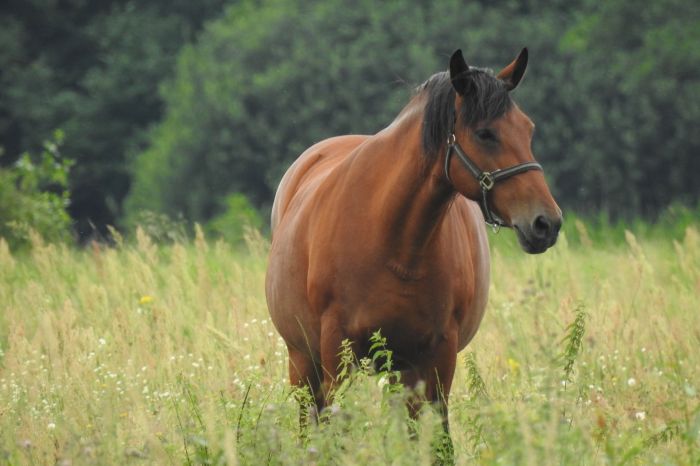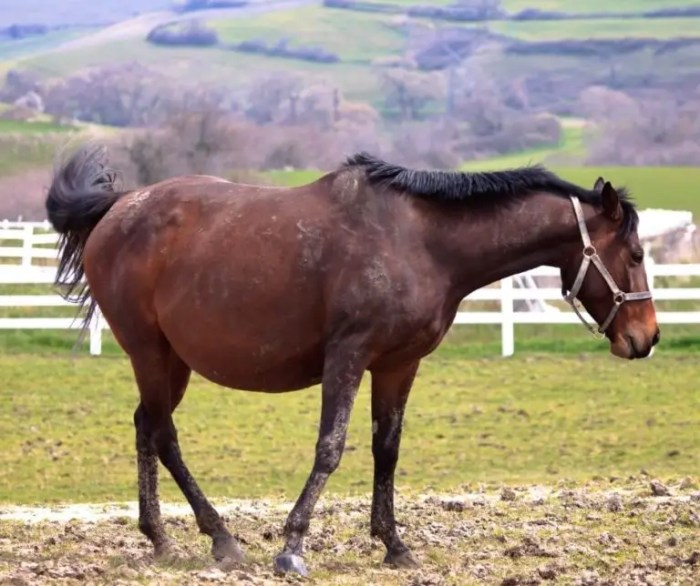The gestation period of mares, a topic often searched as “cuantos meses esta preñada una yegua,” is a crucial aspect of equine breeding and management. Understanding the duration of pregnancy and the factors influencing it is essential for ensuring the well-being of both the mare and her foal.
This guide delves into the intricacies of equine gestation, providing a comprehensive overview of the typical gestation period, signs and symptoms of pregnancy, monitoring techniques, and the care and management of pregnant mares. By exploring these aspects, we aim to empower horse owners and breeders with the knowledge necessary to navigate the journey of equine pregnancy successfully.
Gestation Period of Mares

The gestation period of mares, also known as the pregnancy term, is the time between conception and the birth of a foal. It is typically around 340 days, with a range of 320 to 370 days. However, several factors can influence the duration of pregnancy in horses, including the breed, age, and health of the mare, as well as environmental factors.
Factors Influencing Gestation Period
Several factors can influence the length of gestation in mares, including:
- Breed:Different breeds of horses have slightly different average gestation periods. For example, Thoroughbreds tend to have shorter gestation periods than draft horses.
- Age:Younger mares tend to have slightly longer gestation periods than older mares.
- Health:Mares that are in good health are more likely to have a normal gestation period. Mares with certain health conditions, such as uterine infections, may have shorter or longer gestation periods.
- Environmental factors:Mares that are exposed to extreme heat or cold during pregnancy may have shorter or longer gestation periods.
Signs and Symptoms of Pregnancy in Mares: Cuantos Meses Esta Preñada Una Yegua
Pregnancy in mares can be detected through various physical and behavioral changes that occur during gestation. Understanding these signs and symptoms is crucial for proper monitoring and management of pregnant mares.
The physical and behavioral signs of pregnancy in mares manifest gradually over the gestation period, which typically lasts for approximately 11 months (340-360 days). It’s important to note that these signs may vary in intensity and timing depending on the individual mare and the stage of pregnancy.
Physical Signs
- Enlargement of the abdomen:As the fetus grows, the abdomen of the mare will gradually enlarge, becoming more pronounced in the later stages of gestation.
- Development of the udder:The mammary glands of the mare will begin to develop and enlarge around 6-8 months of pregnancy. This is in preparation for milk production after foaling.
- Relaxation of the pelvic ligaments:The ligaments around the pelvis become relaxed in preparation for foaling, which can be observed as a widening of the mare’s stance.
- Increased urination and defecation:Pregnant mares may experience increased urination and defecation due to the pressure of the growing uterus on the bladder and rectum.
Behavioral Signs, Cuantos meses esta preñada una yegua
- Changes in appetite:Pregnant mares may experience changes in appetite, including increased hunger or decreased interest in certain foods.
- Lethargy and reduced activity:As the pregnancy progresses, mares may become less active and show signs of lethargy due to the physical demands of carrying the fetus.
- Nesting behavior:In the weeks leading up to foaling, mares may exhibit nesting behavior, such as pawing at the ground and seeking out secluded areas.
- Increased vocalization:Pregnant mares may vocalize more frequently, especially during the later stages of gestation.
Monitoring Pregnancy in Mares

Monitoring pregnancy in mares is crucial to ensure the health and well-being of both the mare and the developing fetus. Various methods can be employed to monitor pregnancy, each offering unique advantages and limitations.
Physical Examinations
Physical examinations involve a thorough physical assessment of the mare, including her overall condition, body weight, and reproductive tract. Pregnancy can be suspected based on changes in the mare’s body shape, such as an enlarged abdomen and a protruding vulva.
Ultrasonography
Ultrasonography is a non-invasive imaging technique that allows for visualization of the developing fetus and its structures. It is commonly used to confirm pregnancy, determine fetal viability, and monitor fetal growth and development.
Blood Tests
Blood tests can be used to detect pregnancy-specific hormones, such as equine chorionic gonadotropin (eCG). These tests are typically used early in pregnancy, as eCG levels rise significantly during the first trimester.
Care and Management of Pregnant Mares

Pregnant mares require special care and management to ensure the health and well-being of both the mare and her developing foal. This includes providing adequate nutrition, exercise, and environmental conditions, as well as implementing appropriate vaccinations and parasite control measures.
Nutritional Requirements
Pregnant mares have increased nutritional demands, particularly in the later stages of gestation. A well-balanced diet that meets these demands is crucial for the proper development of the foal and the maintenance of the mare’s health. The diet should be high in quality forage, such as hay or pasture, and supplemented with grain or concentrates as needed.
The amount of grain or concentrate required will vary depending on the mare’s individual needs and the quality of the forage available.
In addition to providing adequate calories, the mare’s diet should also be rich in essential nutrients, including protein, vitamins, and minerals. Protein is essential for the growth and development of the foal’s muscles, bones, and organs. Vitamins and minerals are necessary for a variety of bodily functions, including immune system support, bone health, and energy metabolism.
Exercise Requirements
Regular exercise is important for pregnant mares. Exercise helps to maintain the mare’s cardiovascular health, muscle tone, and overall well-being. It can also help to prevent complications during pregnancy and foaling. However, it is important to avoid strenuous exercise, particularly in the later stages of gestation.
Light to moderate exercise, such as walking or light trotting, is generally safe for pregnant mares.
Environmental Requirements
Pregnant mares should be provided with a clean, dry, and well-ventilated environment. The mare’s stall should be large enough to allow her to move around comfortably and should be free of hazards that could cause injury. The mare should also have access to fresh water at all times.
Vaccinations and Parasite Control
It is important to keep pregnant mares up-to-date on their vaccinations to protect them from diseases that can be harmful to both the mare and her foal. Core vaccines for pregnant mares include tetanus, influenza, and equine herpesvirus (EHV). Other vaccines may be recommended depending on the mare’s individual needs and the risk of exposure to specific diseases.
Pregnant mares should also be regularly dewormed to prevent parasitic infections. Parasites can cause a variety of health problems in mares, including anemia, weight loss, and diarrhea. Deworming should be done according to the recommendations of a veterinarian.
Foaling and Postpartum Care

The foaling process in mares typically lasts several hours and involves three distinct stages. During the first stage, the mare experiences uterine contractions that dilate the cervix. The second stage begins when the amniotic sac appears at the vulva, and the foal is delivered.
The third stage involves the expulsion of the placenta.Providing proper postpartum care is crucial for both the mare and the foal. The mare should be monitored closely for any signs of complications, such as retained placenta or uterine infection. The foal should be examined to ensure it is healthy and is receiving adequate nutrition from its mother.
Steps in Providing Postpartum Care for Mares and Foals
For the Mare:
- Monitor the mare’s vital signs, including temperature, pulse, and respiration.
- Check for any signs of uterine infection, such as a foul-smelling discharge or fever.
- Provide the mare with a clean and comfortable environment to rest in.
- Offer the mare plenty of fresh water and hay.
- If the mare has retained placenta, it should be removed by a veterinarian.
For the Foal:
- Ensure the foal is breathing and nursing properly.
- Check the foal’s vital signs, including temperature, pulse, and respiration.
- Monitor the foal’s weight gain and ensure it is receiving adequate nutrition.
- Provide the foal with a clean and comfortable environment to rest in.
- If the foal is weak or has difficulty nursing, it should be examined by a veterinarian.
Expert Answers
What is the average gestation period for mares?
The average gestation period for mares is approximately 340 days, with a range of 320 to 370 days.
What are the common signs of pregnancy in mares?
Common signs of pregnancy in mares include a swollen vulva, enlarged abdomen, increased appetite, and changes in behavior.
How can pregnancy be confirmed in mares?
Pregnancy in mares can be confirmed through physical examinations, ultrasonography, or blood tests.